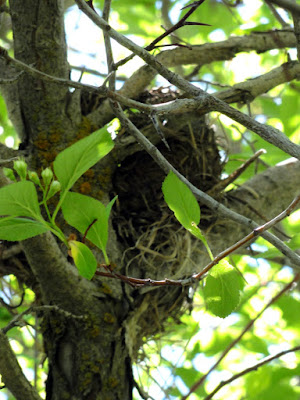Silly me...I had forgotten my pocket "Wild Flowers of Utah" guide.
Pretty little flowers; each one seemed to be at a different coloration phase. How cool!
Now I swear this looks exactly like lupin except it is yellow instead of blue. The leaves are not shaped lupin-like thought.
Maybe God just thought it would be nice to have yellow lupin-like flowers too.
Within the tree circled meadow the air was scented with a fragrance like honeysuckle, lily, and a harsh rank smell combination. I soon figured out that the sweet scent was coming from the yellow vine climbing through a white blossomed tree.
Hum...seems we have a bit of a yellow theme going here today.
They aren't supposed to be out and about during the daytime, but who knows. I sure didn't want any surprise confrontations with a stripey critter.
OK...now take a close look at this tree.
You are looking for the bird...a tiny yellow bird to be exact.
See it? Maybe you can hear it better. Listen closely, the bird is singing like this:
Sweet sweet sweet...sweeter than sweet....sweet sweet sweet...I'm so sweet....
And there it is! Or at least a glimpse of the tiny Yellow Warbler!
Can you see the rusty marking on it's chest? That means it is a male.
Here's your factoid:
The scientific name is Dendroica petechia; the first part meaning "tree lover". Petechia is a commonly used medical term referring to reddish or purplish spots on the body, typically caused by minor hemorrhaging of capillary blood vessels. I guess the Yellow Warbler reminded Linnaeus of this malady when he named the critter back in 1766.
(this from an Ohio bird loving blogger)
Dang that little bird is tough to photograph! Every time I spot one, it zips away through the air, after teasing me with it's gorgeous song which you can listen to HERE.
I decided to try to follow one bird inside a tree's canopy. I pushed my way in between the thick branches and looking up I saw this:
Gob smacked! I was so stunned to see such a beautiful nest!It was about the size of a soft ball, and completely covered with a soft looking plant down or perhaps spider web, very tidy and tightly woven. I was impressed!
Not wanting to disturb the scene I took my pictures and moved on.
The ground beneath me was covered with a plant that looked vaguely like bamboo.The tiny flowers smelled quite sweet. Nice and all...but frankly now I was hooked on looking for birds nest!
Two....
Three....
Four.....
Six.. (and extra points for the graceful flowering sprig as a view, and reddish bark for surrounding color. Obviously this bird is the Martha Stewart of the Bird World.)
Now picture me poking about all the trees, still hearing woodland bird calls all around me.
I hear red wing black birds trilling, humming birds whirling (and I am so hoping I will see a hummer's nest), sweet-sweet calls, bunting calls, and the robin's bark like call.
Then suddenly:
Pelicans?
Seriously?
How weird it that. We are no where close to the ocean. Yet...those birds are definitely pelicans. They swirled about over head, swooping low to look at me and then headed east.
What the heck were they doing out here in the mountains and meadow scene?
(Dang...I almost got a good picture of another yellow warbler...almost, but not quite.)I almost got a good shot of the gorgous red wing blackbird that had been calling. Usually I have seen them hanging around as a cloud (cloud being one of the collective nouns for describing red wings. Another noun is a merl).
They have such a memorable call: O-Kaay-LEEEEE or Konk-a-REEE!
(Listen to the call HERE)
Red wing black birds with their red and yellow shoulder patch make regular blackbird seem boring.
Bernie was finished with his fishing attempts at this location: the Weber River was running very high and very fast. No fish were biting; it was time to try another location.
That was OK with me. I showed Bernie my "catches"; I was very excited about getting a picture of a yellow warbler's nest. He was excited too!
To be continued....


























2 comments:
I haven't seen a red-wing blackbird in years! They used to hang out in the reeds and cat tails in the lagoons of Carlsbad when I was a kid.
I would love to see how birds manage to build such amazing nests with just a beak, and I suppose they use one of their feet also...who knows!
Maybe those pelicans were following the sea gulls. Yes, what on earth were they doing all the way over in Utah??? Do pelicans migrate? That is an amazing photo, by the way...
You are the most fascinating tour guide. I can just imagine you strolling through the meadows. .how absolutely amazing to find so many nests. I could find dozens in my hedge but I won't look since it would mean disturbing the young. .and momma wouldn't be appreciating that.
Post a Comment